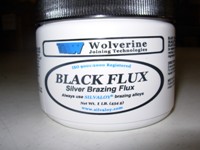How to braze- part 2
Welcome to our series on how to braze! We have put together a tutorial on how to braze and broken it up into 4 parts. We will be adding a new post every few days so be sure to check in and visit us often so you can take advantage of this valuable information. In part 1 of this series we discussed saw plate and how to prepare the saw plate for brazing. In part 2 of this series we will be discussing how Brazing flux affects the brazing process.
When brazing carbide tips you will need:
- Braze Alloy or silver solder
- Brazing Flux
- Carbide tips
- Steel saw plate
- Also, you will need a tool to heat the braze alloy
- And you will also need a tool to help guide the carbide tip onto the saw plate.
*For successful brazing the quality of the materials used is very important and can have a significant effect on reducing the amount of tip loss and breakage you experience. We proudly sell what we believe to be some of the best brazing flux, Braze alloy, and Carbide Tips in the industry.
Part 2- Brazing Flux
Choosing a good brazing flux:
There are three types of brazing flux: White Flux, Black Flux And Purified Black Flux.
White Flux is potassium salts of boron and fluorine. It has some cleaning effect to remove oils and greases. It has some ability to remove existing oxides. Do not count on either one of those. Start with a clean saw plate that is oxide free. Flux, any flux, is designed to keep oxygen away from the braze alloy so that the braze alloy melts and flows instead of burning up.
Black Flux is white flux with extra boron added. Black flux is clearly superior to white flux for brazing carbide saw tips to saws. The simple switch from white flux to black flux can prevent or entirely eliminate tip loss and breakage.
Purified Black Flux is exactly what the name says. It is black flux that has gone through a separate, final, cleaning, filtering process. Ordinary black flux has some impurities and inert elements in it to keep the cost down. This is just fine if it is used entirely outside of the braze joint. In the case of brazing carbide saw tips to saw blades you also have flux between the braze alloy and the steel. If you are using ordinary black flux you will have these inert elements trapped in the joint. Purified black flux will create a more even braze joint that is typically 20 to 30% stronger than a braze joint created with ordinary black flux.
Flux -Applying Flux
The notches and both sides of the shoulders should have a layer of flux painted on them. It is very important that you get the whole shoulder of the saw plate as the flux helps protect the shoulder from the heat to a certain extent. The main purpose of the flux is to prevent the alloys in the steel from oxidizing. Many saw plates have nickel and chromium in the steel. If flux is not applied to the saw plate these alloying elements can be turned into nickel oxides and chromium oxides or chromium carbides and thus affect the strength of the steel. If you see color on your saw plate after brazing then you need to flux to prevent that coloration.
Tags: black flux, Braze alloy, brazing flux, Flux, how to braze, saw plate, white flux
Leave a Reply




